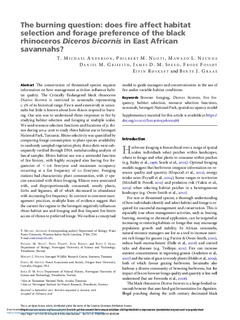| dc.contributor.author | Anderson, T.M. | |
| dc.contributor.author | Ngoti, P. M. | |
| dc.contributor.author | Nzunda, M.L. | |
| dc.contributor.author | Griffith, D. M. | |
| dc.contributor.author | Speed, James David Mervyn | |
| dc.contributor.author | Fossøy, Frode | |
| dc.contributor.author | Røskaft, Eivin | |
| dc.contributor.author | Graae, Bente Jessen | |
| dc.date.accessioned | 2019-03-28T12:31:59Z | |
| dc.date.available | 2019-03-28T12:31:59Z | |
| dc.date.created | 2018-10-16T20:47:55Z | |
| dc.date.issued | 2018 | |
| dc.identifier.issn | 0030-6053 | |
| dc.identifier.uri | http://hdl.handle.net/11250/2592212 | |
| dc.description.abstract | The conservation of threatened species requires information on how management activities influence habitat quality. The Critically Endangered black rhinoceros Diceros bicornis is restricted to savannahs representing c. 5% of its historical range. Fire is used extensively in savannahs but little is known about how rhinos respond to burning. Our aim was to understand rhino responses to fire by studying habitat selection and foraging at multiple scales. We used resource selection functions and locations of 31 rhinos during 2014–2016 to study rhino habitat use in Serengeti National Park, Tanzania. Rhino selectivity was quantified by comparing forage consumption to plant species availability in randomly sampled vegetation plots; rhino diets were subsequently verified through DNA metabarcoding analysis of faecal samples. Rhino habitat use was a unimodal function of fire history, with highly occupied sites having fire frequencies of < 0.6 fires/year and maximum occupancy occurring at a fire frequency of 0.1 fires/year. Foraging stations had characteristic plant communities, with 17 species associated with rhino foraging. Rhinos were associated with, and disproportionately consumed, woody plants, forbs and legumes, all of which decreased in abundance with increasing fire frequency. In contrast to common management practices, multiple lines of evidence suggest that the current fire regime in the Serengeti negatively influences rhino habitat use and foraging and that frequent fire limits access of rhinos to preferred forage. We outline a conceptual model to guide managers and conservationists in the use of fire under variable habitat conditions. | nb_NO |
| dc.language.iso | eng | nb_NO |
| dc.publisher | Cambridge University Press | nb_NO |
| dc.rights | Navngivelse 4.0 Internasjonal | * |
| dc.rights.uri | http://creativecommons.org/licenses/by/4.0/deed.no | * |
| dc.title | The burning question: does fire affect habitat selection and forage preference of the black rhinoceros Diceros bicornis in East African savannahs? | nb_NO |
| dc.type | Journal article | nb_NO |
| dc.type | Peer reviewed | nb_NO |
| dc.description.version | publishedVersion | nb_NO |
| dc.source.journal | Oryx | nb_NO |
| dc.identifier.doi | 10.1017/S0030605318000388 | |
| dc.identifier.cristin | 1620905 | |
| dc.description.localcode | © Fauna & Flora International 2018 This is an Open Access article, distributed under the terms of the Creative Commons Attribution licence (http://creativecommons.org/licenses/by/4.0/), which permits unrestricted re-use, distribution, and reproduction in any medium, provided the original work is properly cited. | nb_NO |
| cristin.unitcode | 194,31,10,0 | |
| cristin.unitcode | 194,66,10,0 | |
| cristin.unitname | Institutt for naturhistorie | |
| cristin.unitname | Institutt for biologi | |
| cristin.ispublished | true | |
| cristin.fulltext | original | |
| cristin.qualitycode | 1 | |

